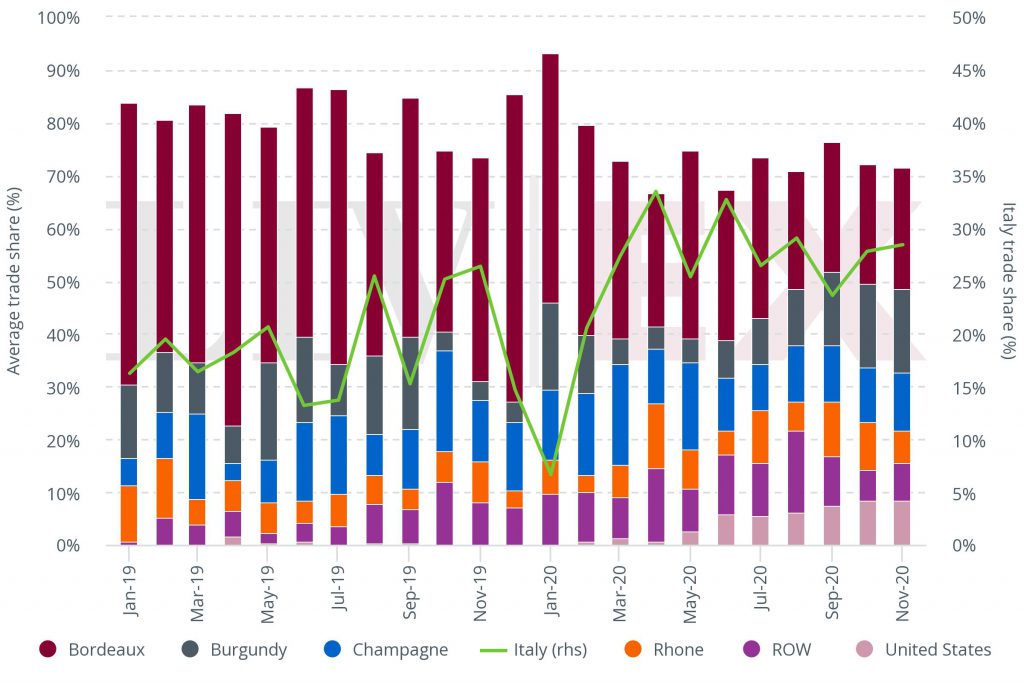What’s happening in the market?
Tuscany has grabbed the eye of traders since the start of the week, taking 17.9% of trade share by value since Monday. This was led by trades of Soldera Case Basse, 100% Sangiovese, Toscana 2013, Tignanello, Toscana 2021andMontevertine, Le Pergole Torte, Toscana 2021.
The US also saw an uptick in trade share, taking 6.2% of trade share so far this week. The region has been buoyed by the 2021 and 2020 vintages of Screaming Eagle, Cabernet Sauvignon, Oakville changing hands, as well as Bond, Quella, Napa Valley 2015.
Today’s deep dive: How have tariffs impacted the fine wine market?
With talk of China imposing retaliatory tariffs on wine from the EU amid ongoing trade disputes, we take a look at previous tariffs that have been imposed on wine, and how they have impacted the global fine wine market.
In October 2019, the US imposed 25% tariffs on European goods, not including wine under 14% ABV. The chart below shows how US purchasing of fine wine changed around this time.
USA regional buying habits as a % of total USA trade share

Before the tariffs were introduced, Bordeaux accounted for 48% of the trade by value on average (Jan 2019 – Oct 2019). From October 2019 to the end of 2020, Bordeaux’s average share of US buying fell to 33%. Burgundy’s share has also declined – from 13% before the tariffs to 8%.
Conversely, demand for regions exempt from the tariffs rose significantly during this time. Champagne rose from 10% to 14%, Italy from 18% to 25% and the Rest of the World from 4% to 10%.
Regions exempt from the 25% US tariffs also saw the biggest price appreciation in 2020.
For the first time on an annual basis, Champagne outperformed all other fine wine regions. Within the Liv-ex 1000, the Champagne 50 sub-index was the biggest mover, up 8.27%. Led by Taittinger, Comtes de Champagne Blanc de Blancs 2008 and Louis Roederer, Cristal 2012 as the critically acclaimed 2008 and 2012 vintages hit the market.
In 2020, China imposed tariffs on Australian wine amid a series of blows to Australian exports. Earlier this year, it was announced that China would lift these tariffs as relations between the countries thawed.
The secondary market for Australian wine shrank in 2021 after the tariffs were introduced, with the country’s trade share by value dropping from 1.6% pre tariffs in 2020, to 1.1% in 2021. The number of Australian LWIN11s (individual wine labels) traded also declined 32.2% year-on-year.
Furthermore, the impact was obvious on leading brands. For example, Penfolds Grange fell from fifth place in the Power 100 ranking pre tariffs, to 45th place by 2021. It should be noted, that Penfold Grange 11th place in the 2023 rankings.
What will happen if China goes ahead with its threat to impose tariffs on the EU? If Donald Trump regains the presidency, will higher US tariffs be on cards? Whatever happens, it will not be good news. That is clear.
Our Bordeaux En Primeur 2023 page contains everything you need to know about this year’s campaign. You can also sign up for our daily En Primeur email alerts using the form below.




